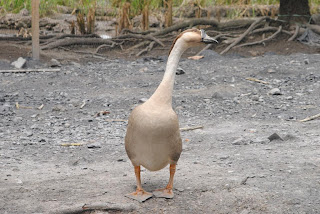Males are extremely similar to greens and are sometimes indistinguishable. The neck is green and the wings dark. As well as the white facial patch, emeralds also have a patch of yellow and a tint of blue, characteristics of greens. Frankly speaking, Java greens are most beautiful than this hybrid.
Hens vary greatly within this variety. The neck is solid green and iridescent. The chest and wings are varying shades of dark brown and rust. Females also have a patch of yellow and tints of blue in their facial patch.
Emerald Spalding chicks are noticeably darker than India Blue peachicks, especially on their chest, which is brown rather than cream, and their back, which is almost black. Most emerald chicks' legs have a brown tinge rather than pink. Their heads also differ slightly in shape from blues'.
Emerald Spaldings came out of extensive genetic work with spalding peafowl. Many individuals attempted to breed birds that would retain the beauty of green peafowl but be better adapted to captive life. Emerald Spaldings are less flighty and aggressive than greens, and can better deal with cold weather. However, they are still much poorer in these regards then India Blue and its variations.
Looking at Malaysia situation, all hybrid types are free from any licenses. No license is needed to get it as yours. But sometimes, the confusion would happen when distinguish between Java green and these. Sometimes, Wildlife Department will stated as Java Green. To prove, show them the receipt, health certification, permit which mentioned it is Hybrid. However, due to lack knowledge among the peoples, the last resort is, conducting DNA.
These are some pictures of my spalding collection.



























